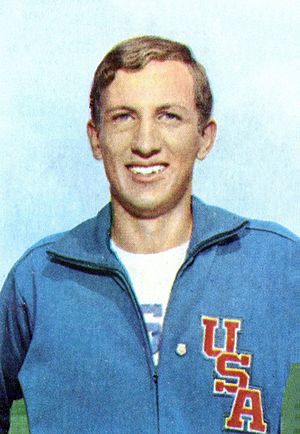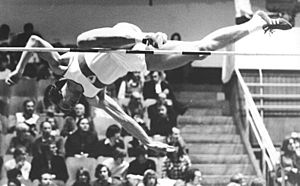Dick Fosbury facts for kids

Fosbury in 1968
|
||||||||||||||
| Personal information | ||||||||||||||
|---|---|---|---|---|---|---|---|---|---|---|---|---|---|---|
| Born | March 6, 1947 Portland, Oregon, U.S. |
|||||||||||||
| Died | March 12, 2023 (aged 76) Salt Lake City, Utah, U.S. |
|||||||||||||
| Height | 6 ft 4 in | |||||||||||||
| Weight | 183 lb | |||||||||||||
| Sport | ||||||||||||||
| Country | United States | |||||||||||||
| Sport | Athletics | |||||||||||||
| Event(s) | High jump | |||||||||||||
| College team | Oregon State University | |||||||||||||
| Club | Oregon State Beavers, Corvallis | |||||||||||||
| Achievements and titles | ||||||||||||||
| Personal best(s) | 2.24 m (7 ft 4¼ in) (1968) | |||||||||||||
|
Medal record
|
||||||||||||||
Richard Douglas Fosbury (March 6, 1947 – March 12, 2023) was an American high jumper. He is known as one of the most important athletes in track and field history.
He won a gold medal at the 1968 Olympics. There, he changed the high jump forever with his "back-first" technique. This method is now called the Fosbury flop. He would sprint diagonally, then curve and leap backwards over the bar. This allowed his body's center of gravity to be lower during the jump.
Almost all high jumpers today use his technique. After his Olympic win, Fosbury stayed involved in athletics. He also served on the board of the World Olympians Association. Later in life, he became a local politician in Idaho.
Contents
Dick Fosbury's Amazing Athletic Career
How the Fosbury Flop Began
Dick Fosbury was born in Portland, Oregon. He started trying out new high-jumping techniques when he was 16. This was while he was at North Medford High School.
At first, Fosbury struggled with the popular high-jumping styles of his time. One common method was the straddle technique. In this method, jumpers went over the bar face down. They lifted their legs one at a time. Fosbury found this difficult to do.
So, he began to try different ways to jump. He later said, "I knew I had to change my body position." This led to his new technique. He first tried an "upright scissors method." In this style, a jumper runs forward and lifts their legs one at a time over the bar. High jump rules only say you must jump off one foot. There are no rules about how you cross the bar.
As he practiced, he changed his jump to feel more comfortable. He also wanted to get more height. His early attempts looked a bit awkward. But soon, he started clearing higher jumps.
Over time, Fosbury began to go over the bar backwards, head-first. He would curve his body and kick his legs up. This meant he landed on his back. Luckily, his high school had replaced its hard wood chip landing pit. They now had a much softer material.
In the early 1960s, many schools in the U.S. started using soft foam rubber landing pits. Before this, jumpers landed on sawdust or sand. The new foam pits were much safer for landing on your back. This allowed Fosbury to develop his unique style.
Fosbury's coaches first wanted him to stick with the straddle method. But they changed their minds when his jumps kept getting better. In his junior year, he broke his high school record. He jumped 1.91 meters (6 feet 3 inches). The next year, he placed second in the state. He jumped 1.97 meters (6 feet 5.5 inches).
His new technique became known as the "Fosbury Flop." A newspaper in 1964 ran a photo with the caption "Fosbury Flops Over Bar." A reporter wrote that he looked like "a fish flopping in a boat."
College Years and Refining the Flop
After high school, Fosbury went to Oregon State University. His coach, Berny Wagner, thought Fosbury would do better with the "western roll" technique. He encouraged Fosbury to keep practicing it. But Fosbury was allowed to use his "flop" in freshman meets.
The debate ended in Fosbury's second year. He jumped 2.08 meters (6 feet 10 inches) in his first meet. This broke the school record. Fosbury remembered his coach saying, "That's enough." His coach then began to study and film Fosbury's unique jump.
News about Fosbury's unusual style spread. He was even on the cover of Track and Field News magazine in 1968. Fosbury won the 1968 National Collegiate Athletic Association (NCAA) title using his new technique. He won this title two years in a row. He also won the U.S. Olympic Trials.
Fosbury kept making his technique better. He developed a curved, J-shaped approach run. This helped him gain speed. The curved steps helped him rotate his hips. As he got faster, he jumped higher.
He also learned to adjust his takeoff spot as the bar went up. His jump followed a curve in the air. To get more "flight time," he had to take off farther from the bar. This was a mental challenge, as jumpers usually want to be closer. When he jumped over 2.13 meters (7 feet), he took off almost 1.2 meters (4 feet) from the bar.
Fosbury's Gold Medal at the 1968 Olympics
After winning the NCAA title, Fosbury won the U.S. Olympic trials. This was in Los Angeles. He jumped 2.16 meters (7 feet 1 inch). His spot on the Olympic team was still not certain. This was because the Olympics were in Mexico City, which has a high altitude.
Another competition was held in September. Fosbury and two other jumpers cleared 2.18 meters (7 feet 1.75 inches). They then cleared 2.20 meters (7 feet 2.5 inches). This set the three-person Olympic team.
At the 1968 Olympics in Mexico City, Fosbury won the gold medal. He set a new Olympic record at 2.24 meters (7 feet 4.25 inches). This showed how powerful his new technique was.
In the finals, only three jumpers cleared 2.20 meters. Fosbury was in the lead because he cleared every height on his first try. At the next height, 2.22 meters (7 feet 3.5 inches), Fosbury again cleared the bar on his first jump. His teammate, Ed Caruthers, cleared it on his second try. Valentin Gavrilov of the Soviet Union missed all his tries and won the bronze medal (third place).
The bar was raised to 2.24 meters. This would be a new Olympic and U.S. record. Fosbury missed his first two tries. But he cleared it on his third attempt! Caruthers missed all his tries. Fosbury had won the gold medal and broken the American record.
He then asked for the bar to be raised to 2.29 meters (7 feet 6 inches). He hoped to break the world record. But he did not clear it on his final three attempts.
The Fosbury Flop's Lasting Impact
After Fosbury's win, the "Fosbury Flop" quickly became popular. At the next Olympics in 1972, 28 out of 40 high jumpers used his technique. By 1980, 13 of the 16 Olympic finalists used it.
From 1972 to 2000, 34 out of 36 Olympic medalists in high jump used the Flop. It became the most common technique in high jumping.
Fosbury was added to the National Track and Field Hall of Fame in 1981. His high jump was featured in commercials for Mazda and Wuaki TV. In 2015, the music video for Avicii's song "Broken Arrows" was based on Fosbury's story.
Fosbury's Life After Sports
Involvement in Politics
After winning his Olympic medal, Fosbury showed support for the civil rights protest at the games. He raised his fist during the national anthem. Later, he supported a black football player at Oregon State who was removed from the team.
In 2014, Fosbury ran for a seat in the Idaho House of Representatives. He ran as a Democrat. He lost the election. In January 2019, Fosbury became a Blaine County Commissioner.
Personal Life and Legacy
Fosbury earned a degree in civil engineering from Oregon State University in 1972. He later became a co-owner of an engineering company in Ketchum, Idaho. He lived there from 1977.
In 2008, Fosbury was diagnosed with lymphoma, a type of cancer. He had surgery and chemotherapy. In 2009, he announced he was in remission, meaning the cancer was under control. He later stated he was "clear of cancer."
Fosbury was part of the "Champions for Peace" club. This group of famous athletes works to promote peace through sports. He also helped start World Fit. This non-profit organization promotes fitness for young people. It also teaches Olympic ideals.
Dick Fosbury passed away on March 12, 2023, at age 76. He died after a short return of his lymphoma. He is remembered for changing the sport of high jump forever.
Images for kids
See also
 In Spanish: Dick Fosbury para niños
In Spanish: Dick Fosbury para niños





